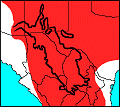


Ursus americanus. Photograph by Mike Bender, courtesy of the U.S. Fish and Wildlife Service.
The best known bear in America, this animal does not ever reach a true state of hibernation, but more of a lethargic period during winter. It is solitary and has activity periods both night and day (Boitani and Bartoli 1983). These are fleet-footed bears that ordinarily are shy and seldom seen. In the wild, they use runs or travelways which are taken advantage of by hunters. They have few predators other than man, and their chief economic value is as a game animal (Davis and Schmidly 1994).
These bears are medium-sized and black or brown in color with a brownish snout. Long, curved front claws are adapted for climbing (Davis and Schmidly 1994). The length of the head and body is up to 180 cm with a short tail (12 cm). A shoulder height of 60-90 cm and weight of 102-227 kg is common (Boitani and Bartoli 1983.
Ursus americanus is mostly restricted to higher mountainous, wooded regions and desert edges, especially along streams and rivers (Cockrum 1982. As expert climbers, they are capable of seeking refuge in trees. They are known to "hole up" under shelving rock, in windfall at the base of a tree, and in other acceptable sites (Davis and Schmidly 1994.
The Black Bear can be found across much of the northern United States and into Canada. However, they range as far south as New Mexico and into western Texas (Boitani and Bartoli, 1983).
Omnivorous by nature, this bear's diet consists often of the carrion from another predator's kill or of garbage found around human-populated areas (Cockrum 1982). Also eaten are berries, insects, eggs, and honey (Burt 1980).
Young are born in a winter den, usually in January or February. Two is the average number of cubs born at any one time, but up to six have been reported. Gestation is 7-71/2 months, cubs weigh 198-340 g at birth and are weaned around August with independence occurring about 1 year after birth (Burt 1980).
Boitani, L., and Bartoli, S. 1983. Simon and Schuster's Guide to Mammals. Simon and Schuster, New York, 511 pp.
Burt, William Henry. 1980. Peterson Field Guides: Mammals. Houghton Mifflin Company, Boston, 289 pp.
Cockrum, E. L. 1982. Mammals of the Southwest. University of Arizona Press, Tucson, 176 pp.
Davis, W. B., and Schmidly, D. J. 1994. The Mammals of Texas. Texas Parks and Wildlife Press, Austin, 338 pp.
§ Mammals of Texas—Online Edition.
Todd Spurgeon, Student, October 1997.
Last Update: 26 Jul 2009